8.1: So, the Texas Governor Is Like the U.S. President, Right?
- Page ID
- 129180
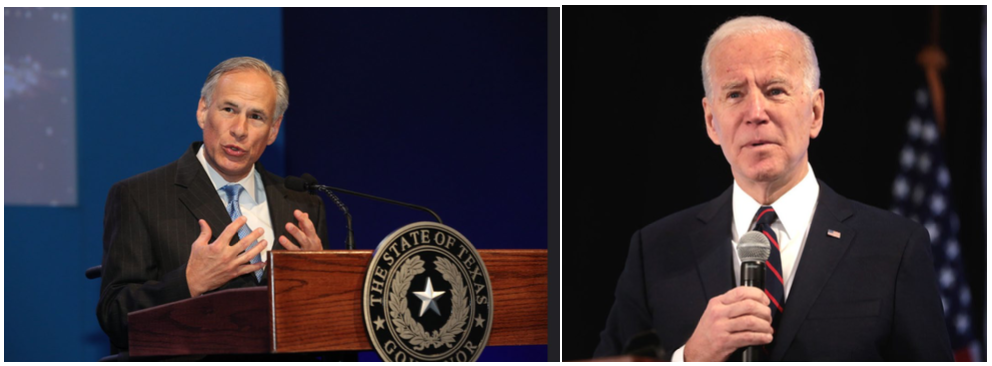
The Texas Constitution was written at a time when concentrated power in the hands of a single state official was viewed with great apprehension. E. J. Davis, the last Republican governor before William Clements was elected in 1979, held office from 1870 to 1874, and his administration was characterized by corruption, scandal, and repression. Consequently, when the Democrat-controlled delegation drafted the 1876 Constitution, the framers reacted against the Davis administration by creating a constitutionally weak governor. The 1876 Constitution remains in effect, even though it has been liberally amended.
Today, the governor still copes with a highly fragmented executive branch that results in a plural executive, one in which the governor must share executive power and often compete with five other elected executives, an appointed executive, and elected boards of the Texas Railroad Commission and the State Board of Education. The executive branch also includes a complex system of powerful policymaking bureaucratic entities. The Texas governor is one of seven equally powerful officials who head the executive branch, unlike the U.S. president (Figure 8.3).2
Ok so they can’t all be governor, but they can still make up the executive branch in Texas. One official, the secretary of state, is appointed by the governor. Five others are, in addition to the governor, elected on partisan ballots for four-year terms: lieutenant governor; attorney general; comptroller; agriculture commissioner; and land commissioner. These elected officials are, in theory, directly accountable to the citizenry for their performance and their integrity in office. One of these elected officials is the lieutenant governor and the other four are department heads.
Lieutenant Governor
The current lieutenant governor is Dan Patrick (Figure 8.4), who as lieutenant governor presides over the Texas Senate but does not head any executive office (see Chapter 6 on the Texas legislature). The lieutenant governor performs as an executive only when the governor is away from the state or upon succession to the governorship.
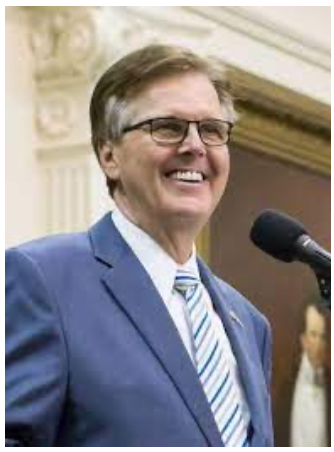
Attorney General
Along with the governor, the lieutenant governor, and the speaker of the House, the attorney general—Ken Paxton (Figure 8.5)—is one of the most powerful officers in Texas government. Although candidates for the position often run on a strong anticrime platform, the work of the office is primarily civil. As the attorney for the state, the attorney general and his or her staff represent the state and its agencies in court when the state is a party to a case. The Office of the Attorney General also is responsible for such varied legal matters as antitrust litigation, workers' compensation insurance, organized crime control, and environmental protection.
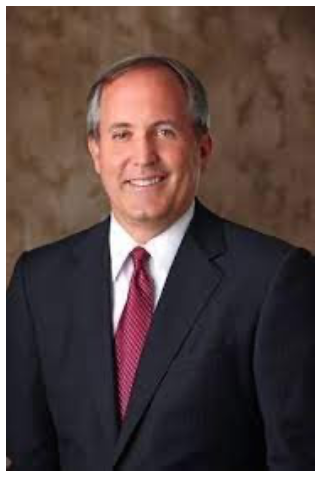
The attorney general's greatest power, however, is that of issuing opinions on questions concerning the constitutionality or legality of existing or proposed legislation and administrative actions. These opinions are not legally binding, but they are rarely challenged in court and thus effectively have the same importance as a ruling by the state's supreme court. Because the attorney general's opinions are often well publicized, and because the attorney general works with all state agencies, the office is second only to the governor's office in the public recognition it receives. Because the positron is regarded as a stepping stone to the governor's office, attorneys general release favorable publicity about themselves, their agency, and their support groups, often with an eye to possible future election campaigns.
Comptroller of Public Accounts
The current comptroller is Glenn Hegar (Figure 8.6). As comptroller, he is responsible for the administration of the suite tax system and for performing preaudits of expenditures by state agencies. In addition, as part of the budget process. the comptroller certifies to the legislature the approximate biennial income for the state. The Texas Constitution requires the state to operate under a balanced budget and precludes the legislature from appropriating more funds than are anticipated in state revenues for any biennial period. Since the elimination of the treasurer's office in 1996. the comptroller serves as the state's banker. The merger of the two offices further strengthened the comptroller's office.
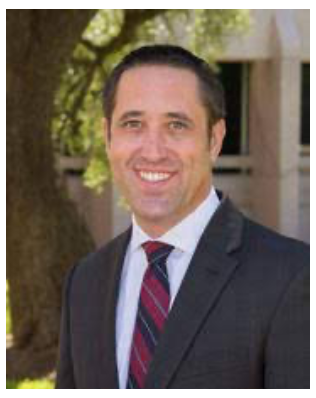
The comptroller is also the custodian of all public monies and of the securities in which the state invests or holds in trust. The office also issues the excise tax stamps used to indicate the collection of taxes on the sale of alcoholic beverages and cigarettes in the state. In short, the comptroller collects, safeguards. and invests the state's revenues.
Commissioner of the General Land Office
Only Texas and Alaska entered the Union with substantial public land acreage, and only these two states officials. Law officers are then responsible have land offices. George P. Bush (Figure 8.7) is the current commissioner of the General Land Office, first elected to a four year in 2014 and reelected in 2018.
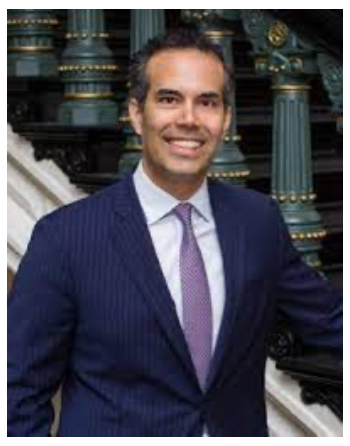
As commissioner, Bush administers about 22.5 million Texas acres. This acreage includes four million acres of bays, inlets, and other submerged land from the shoreline to the three-league marine limit (10.36 miles out). The land commissioner's land-management responsibilities include: supervising the leasing of all state-owned lands for such purposes as oil and gas pro-duction, mineral development, and grazing (over 14,000 leases); administering the veterans' land program, through which veterans may buy land with low-interest loans backed by state bonds; and maintaining the environmental quality of public lands and waters, especially coastal lands. Like all land commissioners, he must balance environmental interests with land and mineral interests.
Commissioner of Agriculture
Farming and ranching remain important industries in the state, even though only about one percent of the population is engaged in agriculture. The Texas Department of Agriculture, like its national counterpart, is responsible both for the regulation and promotion (through research and education) of the agribusiness industry and for consumer protection, even though these functions may sometimes conflict. For example, requiring that pesticides be safe for workers, consumers, and the environment may be detrimental to the profits of farmers. The diversity of the department's activities (enforcing weights and measures standards, licensing egg handlers, determining the relative safety of pesticides, and locating export markets for Texas agricultural products) further complicates the commissioner's position.
Texas Agricultural Commissioner Sid Miller (Figure 8.8) grants amnesty to cupcakes in the following video! Don’t worry he includes cakes and pies too. In his typical flamboyant style, Miller reassures parents that the ban on junk food, including cupcakes, is no longer in effect in Texas.3
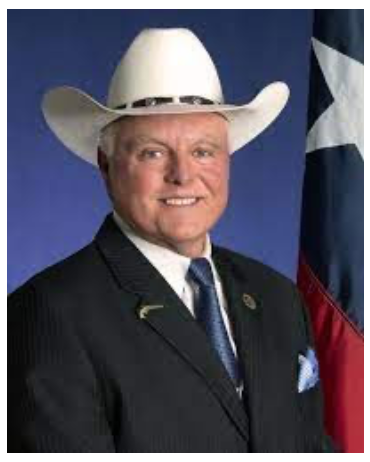
Secretary of State
The secretary of state makes up a part of the plural executive and is the only member of the executive who is appointed. The office of secretary of state was established by Article 4, Sections 1 and 21 of the Constitution of 1876. Ruth R. Hughs (Figure 8.9) is the current secretary of state. The secretary of state is appointed by the governor and confirmed by the Senate and serves for four years. Breaking news!! The Secretary of State Ruth R. Hughs resigns effective the end of May 2021 leaving Governor Greg Abbott to appoint his fifth Secretary of State during his time in office.
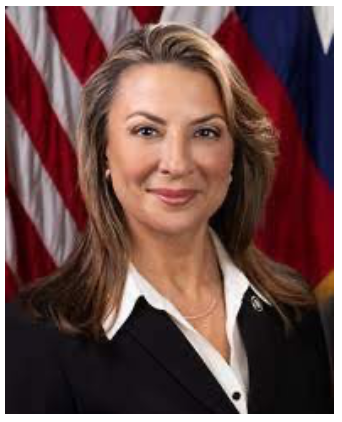
The job of a secretary of state varies from one state to another and even from one country to another. Most of the time this job is out of the public's view, but sometimes events thrust a secretary of state into the public spotlight. Many secretaries of state are involved in the elections of that state. That's the case in Texas. For several months at a time, the office of the secretary of state is very busy preparing for elections. While the actual work of running an election often falls to local governments, secretaries of state are responsible for the outcomes. Those responsibilities include deciding whose vote will count and whose will not.
The other duties of a secretary of state vary considerably. In addition to certifying elections (by verifying the validity of the returns), the other duties of a secretary of state include maintaining records on campaign expenditures; safeguarding the list of lobbyists who register with the state; administering the Uniform Commercial Code; publishing the Texas Register (the official record of administrative decisions, rules, regulations, and announcements of hearings and pending actions); affixing the state seal to proclamations, commissions to office, and other official documents; maintaining a file of the official acts of the governor and the legislature; administering the primary and election laws (as the state's chief election officer); issuing charters of incorporating businesses; assessing and collecting the franchise tax on corporations; administering the laws concerning the sale of securities; and appointing notaries public. The newest duty of the secretary is serving as the states international protocol officer. The office employs over 200 people.
A Woman's Place Is in the House, Senate, and the Governor's Mansion.

Did you know that Texas was only the second state to have a female governor and only a few states have had more female governors than Texas? Only two women—Miriam (Ma) Ferguson and Ann Richards—have held the position of Texas governor. Both made history in Texas politics as women governors. The first, a loyal wife to her political husband, served in an era when women's active involvement in politics and governments was unthinkable. The other was a divorced woman who won the office at a time when a woman's opportunities seemed boundless. Both were Democrats. The first woman governor in Texas set the precedent for the second, who rewrote state and national history decades later when her election allowed Texas to boast itself as the only state to have elected two women to the governor's office—a record that stood until 1997. Both opened political arenas for other women, including those currently serving Texas, that may not have been available but for their service. Both faced great challenges during their prepolitical lives. One remained faithful to her husband as he dealt with allegations of impropriety and corruption, impeachment, conviction, and removal from office. The other faced the personal challenges of divorce and alcoholism. In addition, both encountered incredible adversity during their campaigns and terms. One had to deal with the negative legacy of her husband’s governorship, the influence of powerful and sometimes threatening interest groups, and the political savvy of renowned "old guard" politicians. The other had to run against perhaps the single most bloodthirsty field of primary and general election opponents in Texas politics and deal with the innumerable issues and problems left by her predecessor. In both instances, the women won election as governor in part due to the political and personal gaffes committed by men who never envisioned the women's victories. Yet, both women persevered and are now counted among only thirty women who have been elected to the governor's office nationwide.
In 1994, Richards lost the governor's race to George W. Bush, taking forty-six percent of the vote to Bush's fifty-three percent, despite spending twenty-three percent more than the Bush campaign. Before leaving office, she said, "I did not want my tombstone to read, 'She kept a really clean house! I think I'd like them to remember me by saying/She opened government to everyone."
2. Texas Const., art. III, § 1.
3. Cite Eva Hershaw, “Agriculture Commissioner Grants Amnesty to Cupcakes in First Official Act,” Texas Tribune, Jan. 12, 2015, https://www.texastribune.org/2015/01...esty-cupcakes/.

